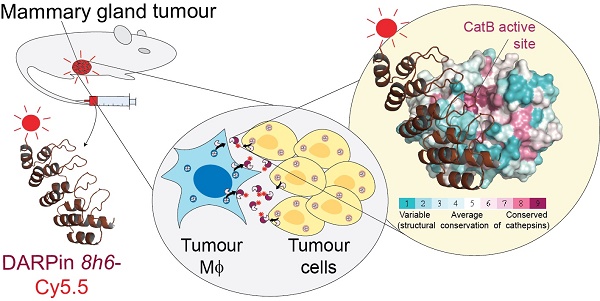当前位置:
X-MOL 学术
›
Theranostics
›
论文详情
Our official English website, www.x-mol.net, welcomes your
feedback! (Note: you will need to create a separate account there.)
Visualizing Nerve Injury in a Neuropathic Pain Model with [18F]FTC-146 PET/MRI
Theranostics ( IF 12.4 ) Pub Date : 2017-07-08 , DOI: 10.7150/thno.19378 Bin Shen 1 , Deepak Behera 1 , Michelle L James 1 , Samantha T Reyes 1 , Lauren Andrews 1 , Peter W Cipriano 1 , Michael Klukinov 2 , Amanda Brosius Lutz 3 , Timur Mavlyutov 4 , Jarrett Rosenberg 1 , Arnold E Ruoho 4 , Christopher R McCurdy 5 , Sanjiv S Gambhir 1, 6 , David C Yeomans 2 , Sandip Biswal 1 , Frederick T Chin 1
Theranostics ( IF 12.4 ) Pub Date : 2017-07-08 , DOI: 10.7150/thno.19378 Bin Shen 1 , Deepak Behera 1 , Michelle L James 1 , Samantha T Reyes 1 , Lauren Andrews 1 , Peter W Cipriano 1 , Michael Klukinov 2 , Amanda Brosius Lutz 3 , Timur Mavlyutov 4 , Jarrett Rosenberg 1 , Arnold E Ruoho 4 , Christopher R McCurdy 5 , Sanjiv S Gambhir 1, 6 , David C Yeomans 2 , Sandip Biswal 1 , Frederick T Chin 1
Affiliation

|
The ability to locate nerve injury and ensuing neuroinflammation would have tremendous clinical value for improving both the diagnosis and subsequent management of patients suffering from pain, weakness, and other neurologic phenomena associated with peripheral nerve injury. Although several non-invasive techniques exist for assessing the clinical manifestations and morphological aspects of nerve injury, they often fail to provide accurate diagnoses due to limited specificity and/or sensitivity. Herein, we describe a new imaging strategy for visualizing a molecular biomarker of nerve injury/neuroinflammation, i.e., the sigma-1 receptor (S1R), in a rat model of nerve injury and neuropathic pain. The two-fold higher increase of S1Rs was shown in the injured compared to the uninjured nerve by Western blotting analyses. With our novel S1R-selective radioligand, [18F]FTC-146 (6-(3-[18F]fluoropropyl)-3-(2-(azepan-1-yl)ethyl)benzo[d]thiazol-2(3H)-one), and positron emission tomography-magnetic resonance imaging (PET/MRI), we could accurately locate the site of nerve injury created in the rat model. We verified the accuracy of this technique by ex vivo autoradiography and immunostaining, which demonstrated a strong correlation between accumulation of [18F]FTC-146 and S1R staining. Finally, pain relief could also be achieved by blocking S1Rs in the neuroma with local administration of non-radioactive [19F]FTC-146. In summary, [18F]FTC-146 S1R PET/MR imaging has the potential to impact how we diagnose, manage and treat patients with nerve injury, and thus warrants further investigation.
中文翻译:

使用 [18F]FTC-146 PET/MRI 可视化神经性疼痛模型中的神经损伤
定位神经损伤和随之而来的神经炎症的能力对于改善患有与周围神经损伤相关的疼痛、无力和其他神经系统现象的患者的诊断和后续治疗具有巨大的临床价值。尽管存在几种用于评估神经损伤的临床表现和形态学方面的非侵入性技术,但由于特异性和/或敏感性有限,它们常常无法提供准确的诊断。在此,我们描述了一种新的成像策略,用于在神经损伤和神经性疼痛的大鼠模型中可视化神经损伤/神经炎症的分子生物标志物,即sigma-1受体(S1R)。蛋白质印迹分析显示,与未受伤的神经相比,受伤神经的 S1R 增加了两倍。使用我们的新型 S1R 选择性放射性配体,[ 18 F]FTC-146 (6-(3-[ 18 F]氟丙基)-3-(2-(氮杂环-1-基)乙基)苯并[ d ]噻唑-2( 3H)-一)和正电子发射断层扫描-磁共振成像(PET/MRI),我们可以准确定位大鼠模型中产生的神经损伤部位。我们通过离体放射自显影和免疫染色验证了该技术的准确性,这证明了 [ 18 F]FTC-146 的积累和 S1R 染色之间存在很强的相关性。最后,局部施用非放射性[ 19 F]FTC-146 阻断神经瘤中的 S1R 也可以缓解疼痛。总之,[ 18 F]FTC-146 S1R PET/MR 成像有可能影响我们如何诊断、管理和治疗神经损伤患者,因此值得进一步研究。
更新日期:2017-11-01
中文翻译:

使用 [18F]FTC-146 PET/MRI 可视化神经性疼痛模型中的神经损伤
定位神经损伤和随之而来的神经炎症的能力对于改善患有与周围神经损伤相关的疼痛、无力和其他神经系统现象的患者的诊断和后续治疗具有巨大的临床价值。尽管存在几种用于评估神经损伤的临床表现和形态学方面的非侵入性技术,但由于特异性和/或敏感性有限,它们常常无法提供准确的诊断。在此,我们描述了一种新的成像策略,用于在神经损伤和神经性疼痛的大鼠模型中可视化神经损伤/神经炎症的分子生物标志物,即sigma-1受体(S1R)。蛋白质印迹分析显示,与未受伤的神经相比,受伤神经的 S1R 增加了两倍。使用我们的新型 S1R 选择性放射性配体,[ 18 F]FTC-146 (6-(3-[ 18 F]氟丙基)-3-(2-(氮杂环-1-基)乙基)苯并[ d ]噻唑-2( 3H)-一)和正电子发射断层扫描-磁共振成像(PET/MRI),我们可以准确定位大鼠模型中产生的神经损伤部位。我们通过离体放射自显影和免疫染色验证了该技术的准确性,这证明了 [ 18 F]FTC-146 的积累和 S1R 染色之间存在很强的相关性。最后,局部施用非放射性[ 19 F]FTC-146 阻断神经瘤中的 S1R 也可以缓解疼痛。总之,[ 18 F]FTC-146 S1R PET/MR 成像有可能影响我们如何诊断、管理和治疗神经损伤患者,因此值得进一步研究。











































 京公网安备 11010802027423号
京公网安备 11010802027423号